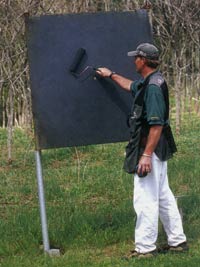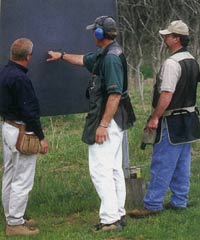
| Article for Sporting Clays Magazine - November 2003 |
| The Magic Pill by Chris Batha |
| continued from previous page... |
 
|
Choke and its effectiveness
are very much affected by your choice of cartridge. In fact, when
choke was first used in shotguns, it actually resulted in worse
patterns. Lead is a very soft metal quite prone to deformity. As
the shot travels down the barrel at great speed and high pressure,
it is inevitable that there will be some damage to its round shape.
The degree of this damage relates directly to pattern quality. The
more deformity, the poorer the pattern. Shot Size The main shot sizes used for clays include No.
9s, 8s, and 7 1/2s. The larger the number the smaller the diameter
of individual pellets--and the less energy per pellet. If you shoot
7/25, you have bigger shot and more striking power but fewer pellets
than in an equivalent load of 8s. A simple rule of thumb is, out
to 35 yards, stick to 8s; past that, 7 1/2s are best. Some shooters
favor smaller 9s for wider, more dense patterns at really close
targets. Recoil In recent articles, we have mentioned recoil, and the shotshell, aside from the weight of the gun, is a big factor in recoil control. You should take this into consideration when making your personal choice of shell. Excessive recoil is both fatigue inducing and the cause of many second-barrel misses. Speed And Lead The difference in lead required
for a 40-yard target between the average and the fastest cartridge
is but a few inches. Surely it is better to find a favorite cartridge
and stick with it than continually experimenting with the rocket
science of velocity's small effect on lead. |
|
Chris Batha is the senior instructor and gun fitter for London Gunmakers E.J. Churchill. He has over 30 years experience in competitive clays shooting and wingshooting worldwide, has an international reputation as a shooting instructor, and has written extensively on all aspects of shotguns and their use. Batha is a former director of the British Clay Pigeon Shooting Association, with formal qualifications from a variety of other bodies, including the British Association of Shooting and Conservation, British City and Guilds, and National Association of Sports Coaches. He offers shooting instruction, gun fitting, and course design throughout the US. Page 2 |